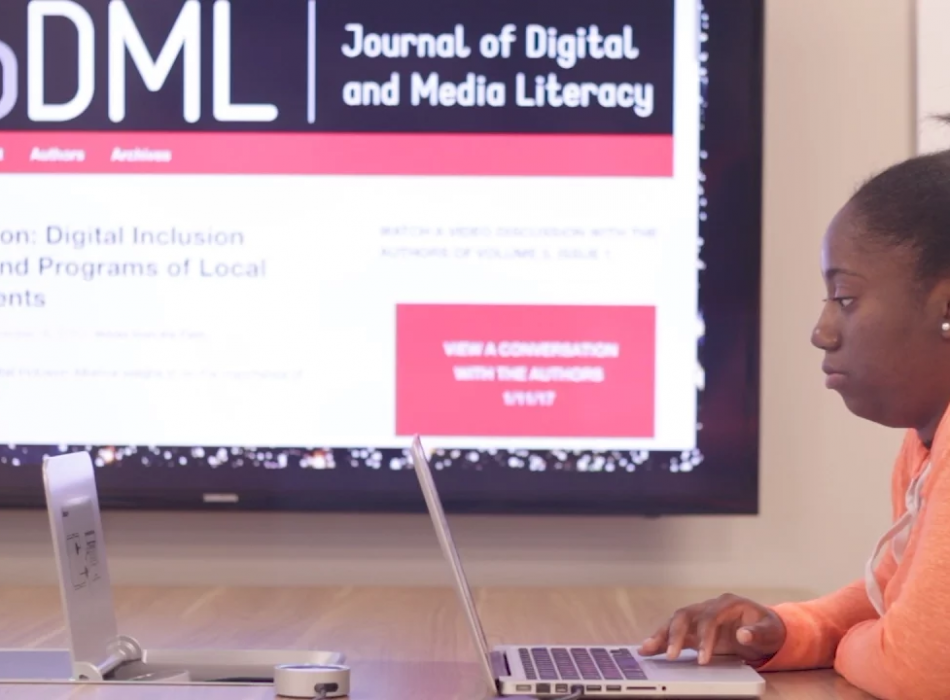Digital Charlotte is one of several digital inclusion initiatives in the Queens Knight School of Communication. Another is the Journal of Digital and Media Literacy, an academic peer review journal. Dr. Alexis Carreiro, an assistant professor at Queens University of Charlotte in the Knight School, edits the journal. It publishes scholarship and articles that focus on digital media literacy. The journal focuses on the ability to access and share information online, create content on multiple platforms, analyze information that you find online, evaluate it, and using these skills to be a digital citizen in a contemporary society. The journal was launched in 2013.
Questions and Answers with Dr. Alexis Carreiro
Can you tell us how JODML connects to the Knight School?
“The Journal of Digital Media Literacy relates to what we’re doing in the Knight school because our goal is to create informed and engaged citizens or consumers of media content. As a school, we work closely with our students to help them figure out how to analyze the information they come across: how to evaluate it, how to access it, and how to figure out if it’s truthful. That’s really important right now in an era of fake news and alternative facts. It’s important that we help students understand how to do that so that they can navigate the world with a high degree of success. That’s exactly what we publish in the journal is articles, videos, and essays. They focus on how individuals use and interpret information they find online, what it means, what value it has, and how communities also are using digital tools to engage in the world around them.”
How does the journal receive its information?
“The journal get its information because authors, scholars, and media practitioners submit their essays and articles for us to review. The way peer-reviewed academic journals usually work is that we’ll get submissions and we’ll send those submissions out to multiple reviewers. They won’t have the name of the author on it so that if you’re a reviewer you won’t know whose work you’re reviewing. The reviewers are actually their peers. We get all of our content through submissions or we will solicit contributions from authors. We also work with guest editors to help curate some of the issues.”
What is the best part about the journal?
“The coolest thing about the journal is that most academic peer review journals are really dense, and we don’t publish work like that. The work that we publish is sophisticated, intellectual, and unique. Part of the requirement for the journal is that it’s readable and accessible by someone with just a high school education. If we are going to write about people and communities that are digitally literate or digitally illiterate in various ways we think that the people we research and write about should be able to read what we write. We should be able to have a conversation with those people. We don’t publish content that’s over anyone’s head, but it’s still intellectual. We write it in a way that includes and welcomes the people we are writing about.”
Why is digital inclusion and digital media literacy a topic that should be talked about?
“So much of the world we live in is online. If there are individuals, families, and communities that don’t have access to being online because they can’t afford it, they are being left behind at an alarmingly fast rate. This is something we really believe in. It relates to equality, equity, and economic opportunity. If you don’t have access/skills in the digital world, you’re not going to be able to get job, to move up in a company, or feed your family.”
How as we as a community spread digital inclusion and shrink the digital divide?
“I think one of the primary things to keep in mind is that not everyone has access. We take it for granted that most people do. The first step is awareness. Being mindful of our privilege in that way and not assuming that everyone does have access. Try to think of ways that you can be more inclusive so you don’t leave anyone out if they don’t have that technology. So that’s the first thing, awareness. Getting politically active in your community.”
